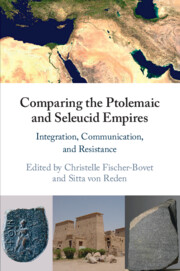Book contents
- Comparing the Ptolemaic and Seleucid Empires
- Comparing the Ptolemaic and Seleucid Empires
- Copyright page
- Contents
- Contributors
- Preface
- Note on Abbreviations
- Maps
- Introduction
- Part I Cities, Settlement and Integration
- Part II Communication and Exchange
- Chapter 5 Imperial and Indigenous Temporalities in the Ptolemaic and Seleucid Dynasties
- Chapter 6 The Visual Representation of Ptolemaic and Seleucid Kings
- Chapter 7 Monetary Policies, Coin Production, and Currency Supply in the Seleucid and Ptolemaic Empires
- Part III Collaboration, Crisis, and Resistance
- Bibliography
- Index
Chapter 5 - Imperial and Indigenous Temporalities in the Ptolemaic and Seleucid Dynasties
A Comparison of Times
from Part II - Communication and Exchange
Published online by Cambridge University Press: 17 September 2021
- Comparing the Ptolemaic and Seleucid Empires
- Comparing the Ptolemaic and Seleucid Empires
- Copyright page
- Contents
- Contributors
- Preface
- Note on Abbreviations
- Maps
- Introduction
- Part I Cities, Settlement and Integration
- Part II Communication and Exchange
- Chapter 5 Imperial and Indigenous Temporalities in the Ptolemaic and Seleucid Dynasties
- Chapter 6 The Visual Representation of Ptolemaic and Seleucid Kings
- Chapter 7 Monetary Policies, Coin Production, and Currency Supply in the Seleucid and Ptolemaic Empires
- Part III Collaboration, Crisis, and Resistance
- Bibliography
- Index
Summary
This chapter compares different temporal regimes developed by the Seleucids and Ptolemies. Kosmin suggests that the Seleucids created a new “historical field” when Seleucus proclaimed a new epoch of Babylonian history and called the year of his conquest of Babylon year 1. The Babylonian historian and priest Berossus, despite writing a history of pre-Seleucid Babylonia, situated himself in the new world of the Seleucids. Yet in Egypt the Ptolemies continued reckoning with traditional regnal years, showing their subordination to traditional uses of historical time. But there were changes, too. Greek regnal years started with the anniversary of the king’s accession, oaths were sworn by the divinized royal members and Demotic dating formulae used the eponymous priests of the royal cult. All this established the Ptolemaic dynasty as a unit and a method of structuring time in its own way. Manetho and Berossus took over dynastic history, creating thirty dynasties up to the Macedonian conquest. The Ptolemies created a neue Zeit, but the Seleucids were more revolutionary. In both empires the local elites and populations participated in shaping the new politics of time.
Keywords
- Type
- Chapter
- Information
- Comparing the Ptolemaic and Seleucid EmpiresIntegration, Communication, and Resistance, pp. 129 - 163Publisher: Cambridge University PressPrint publication year: 2021



